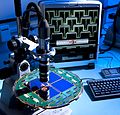
Imagem numa resolução maior (3 000 × 2 884 pixels, tamanho: 842 kB, tipo MIME: image/jpeg)
Este arquivo é do Wikimedia Commons e pode ser utilizado por outros projetos. Sua página de descrição de arquivo é reproduzida abaixo.
Descrição do arquivo
| DescriçãoPIA17993-DetectorsForInfantUniverseStudies-20140317.jpg |
English: Superconducting Detectors for Study of Infant Universe
http://www.jpl.nasa.gov/spaceimages/details.php?id=PIA17993 http://www.jpl.nasa.gov/news/news.php?release=2014-082 The BICEP2 telescope at the South Pole uses novel technology developed at NASA's Jet Propulsion Laboratory in Pasadena, Calif. The focal plane shown here is an array of devices that use superconductivity to gather, filter, detect, and amplify polarized light from the cosmic microwave background -- relic radiation left over from the Big Bang that created our universe. The microscope is showing a close-up view of one of the 512 pixels on the focal plane, displayed on the screen in the background. Each pixel is made from a printed antenna that collects polarized millimeter-wavelength radiation, with a filter that selects the wavelengths to be detected. A sensitive detector is fabricated on a thin membrane created through a process called micro-machining. The antennas and filters on the focal plane are made from superconducting materials. An antenna is seen on the close-up shot in the background with the green meandering lines. The detector uses a superconducting film as a sensitive thermometer to detect the heat from millimeter-wave radiation that was collected by the antenna and dissipated at the detector. A detector is seen on the close-up shot in the background to the right of the pink square. Finally, a tiny electrical current from the sensor is measured with amplifiers on the focal plane called SQUIDs (Superconducting QUantum Interference Devices), developed at National Institute of Standards and Technology, Boulder, Colo. The amplifiers are the rectangular chips on the round focal plane. The focal planes are manufactured using optical lithography techniques, similar to those used in the industrial production of integrated circuits for computers. |
| Data | |
| Fonte | http://photojournal.jpl.nasa.gov/jpeg/PIA17993.jpg |
| Autor | NASA/JPL-Caltech |
Licenciamento
| Public domainPublic domainfalsefalse |
| Esta obra encontra-se no domínio público porque foi criada pela NASA. A política de direitos autorais da NASA diz que "o material da NASA não é protegido por direitos autorais a não ser quando especificado". (página sobre direitos autorais da NASA ou Política de uso de imagens da JPL). |  | |
 |
Avisos:
|
Legendas
Itens retratados neste arquivo
retrata
17 março 2014
Histórico do arquivo
Clique em uma data/horário para ver como o arquivo estava em um dado momento.
| Data e horário | Miniatura | Dimensões | Usuário | Comentário | |
|---|---|---|---|---|---|
| atual | 21h13min de 17 de março de 2014 |  | 3 000 × 2 884 (842 kB) | wikimediacommons>Drbogdan | User created page with UploadWizard |
Uso do arquivo
As seguinte página usa este arquivo:




 " class="attachment-atbs-s-4_3 size-atbs-s-4_3 wp-post-image" alt="O que estudar para o enem 2023">
" class="attachment-atbs-s-4_3 size-atbs-s-4_3 wp-post-image" alt="O que estudar para o enem 2023"> " class="attachment-atbs-s-4_3 size-atbs-s-4_3 wp-post-image" alt="Qual melhor curso para fazer em 2023">
" class="attachment-atbs-s-4_3 size-atbs-s-4_3 wp-post-image" alt="Qual melhor curso para fazer em 2023"> " class="attachment-atbs-s-4_3 size-atbs-s-4_3 wp-post-image" alt="Enem: Conteúdos E Aulas On-Line São Opção Para Os Estudantes">
" class="attachment-atbs-s-4_3 size-atbs-s-4_3 wp-post-image" alt="Enem: Conteúdos E Aulas On-Line São Opção Para Os Estudantes"> " class="attachment-atbs-s-4_3 size-atbs-s-4_3 wp-post-image" alt="Como Fazer Uma Carta De Apresentação">
" class="attachment-atbs-s-4_3 size-atbs-s-4_3 wp-post-image" alt="Como Fazer Uma Carta De Apresentação"> " class="attachment-atbs-s-4_3 size-atbs-s-4_3 wp-post-image" alt="Como Escrever Uma Boa Redação">
" class="attachment-atbs-s-4_3 size-atbs-s-4_3 wp-post-image" alt="Como Escrever Uma Boa Redação"> " class="attachment-atbs-s-4_3 size-atbs-s-4_3 wp-post-image" alt="Concurso INSS edital 2022 publicado">
" class="attachment-atbs-s-4_3 size-atbs-s-4_3 wp-post-image" alt="Concurso INSS edital 2022 publicado">


